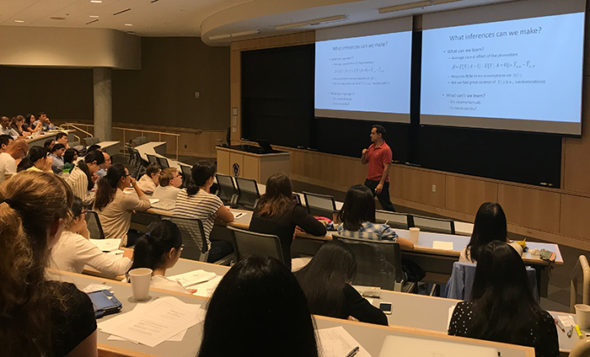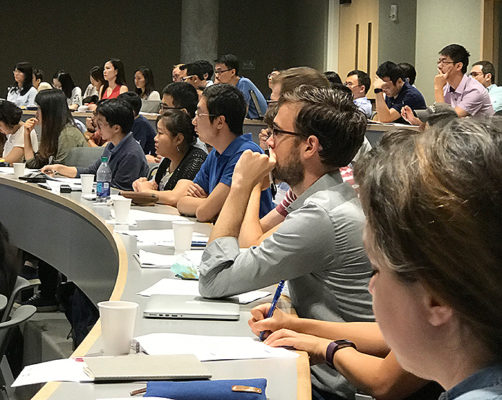Operational risk can have a crippling effect on a company if not managed properly. This is especially true in the financial services industry. Banks and investment firms must pay close attention to variables that have the potential to impact their operations, not only from the breakdown of technology and processes, but also from a personnel perspective. The responsibility of managing one’s money is great, and the inability to properly anticipate and manage potential risk factors can have a devastating effect, all the way up to the industry level. A case in point was the subprime mortgage crisis of the late 2000s, which led to a nationwide economic recession.
 Mike Pinedo, the Julius Schlesinger Professor of Operations Management at New York University’s Stern School of Business, is an expert in risk management research, particularly in the context of the financial services industry. In his presentation at The Boeing Center’s 13th annual Meir Rosenblatt Memorial Lecture, he described the main types of primary risks in a financial services company: market risk, credit risk, and operational risk. Ops risk, which is the risk of a loss resulting from inadequate or failed internal processes, people, or external events, may be the most important factor, he claimed.
Mike Pinedo, the Julius Schlesinger Professor of Operations Management at New York University’s Stern School of Business, is an expert in risk management research, particularly in the context of the financial services industry. In his presentation at The Boeing Center’s 13th annual Meir Rosenblatt Memorial Lecture, he described the main types of primary risks in a financial services company: market risk, credit risk, and operational risk. Ops risk, which is the risk of a loss resulting from inadequate or failed internal processes, people, or external events, may be the most important factor, he claimed.
Pinedo goes on to describe various types of operational costs such as human resources, I.T. investments, and insurance costs, and how they impact corporate risk management. For example, rogue traders can pose a risk if they make inadvisable decisions, so some investment firms choose to take out insurance against that possibility. Other types of ops risk include transaction errors, loss of or damage to assets, theft, and fraud, all of which can pose a catastrophic risk at the industry level. Pinedo adeptly inserted anecdotes into his lecture to provide examples of these risk factors playing out in the real world.
The annual Meir J. Rosenblatt Memorial Lecture brings the “rock stars” of supply chain and operations to the Danforth Campus every fall. Each lecture gives prominent thinkers and practitioners alike the opportunity to hear an expert in the field highlight emerging trends.

This lecture series was established in 2003 to honor the memory of Meir J. Rosenblatt, who taught from 1987 to 2001 at Olin Business School as the Myron Northrop Distinguished Professor of Operations and Manufacturing Management. A leader among faculty, Rosenblatt often won the Teacher of the Year award at Olin and authored the book “Five Times and Still Kicking: A Life with Cancer,” having battled cancer multiple times throughout his life.
For more supply chain digital content and cutting-edge research, check us out on the socials [@theboeingcenter] and our website [olin.wustl.edu/bcsci]
• • •
A Boeing Center digital production
Supply Chain // Operational Excellence // Risk Management
Website • LinkedIn • Subscribe • Facebook • Instagram • Twitter • YouTube



 Feldman studies these challenges using mathematical models that measure customer substitution behavior. He uses these complex modeling problems to estimate the best set of products to offer to the customer.
Feldman studies these challenges using mathematical models that measure customer substitution behavior. He uses these complex modeling problems to estimate the best set of products to offer to the customer.
 “We saw many students going into the job market with supposed ‘structural’ papers which were not meaningfully structural at all,” said Thomadsen who created the workshop in 2010 with Brett Gordon, a professor at Kellogg School of Management.
“We saw many students going into the job market with supposed ‘structural’ papers which were not meaningfully structural at all,” said Thomadsen who created the workshop in 2010 with Brett Gordon, a professor at Kellogg School of Management.



 Answering questions like this is why we need PhDs in marketing.
Answering questions like this is why we need PhDs in marketing. According to Thomadsen, the workshop has two types of sessions: philosophical and technique. “For the philosophical sessions, we want students to understand that when one estimates a structural model (or any model, really), one needs to think about the data generating process behind it. If one cannot identify what variation in the data links the data to the parameter estimates, then one needs to either get better data or use a different model.
According to Thomadsen, the workshop has two types of sessions: philosophical and technique. “For the philosophical sessions, we want students to understand that when one estimates a structural model (or any model, really), one needs to think about the data generating process behind it. If one cannot identify what variation in the data links the data to the parameter estimates, then one needs to either get better data or use a different model.






